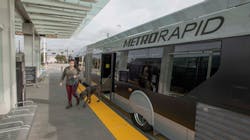Houston METRO: The future of transit is an inclusive one
The Metropolitan Transit Authority of Harris County (Houston METRO) is continuing its efforts to make its system and facilities accessible for all.
Bluetooth bus beacons, Braille signage and better bus stops are just a few examples of how Houston METRO is improving mobility access.
While Houston METRO’s entire fleet of buses and trains is already accessible to people living with disabilities, improvements to bus stops, bus shelters and public facilities make it easier for riders to use the system — giving all customers greater access to mobility.
In 2017, Houston METRO launched a universal design philosophy that ensures compliance with requirements set by the ADA and maximizes benefits to all people, regardless of their age, size or ability. To advance that goal, the authority developed and adopted eight fundamental principles.
Houston METRO’s Universal Accessibility Initiative includes a commitment to ensure all bus stops are compliant with the Americans with Disabilities Act by 2024. New and improved weatherproof signage and innovative technology like Houston METRO’s Bluetooth beacon app will help customers find their way when using the system. Installation of new shelters and improving sidewalks leading to bus stops will make stops more comfortable for all users. The initiative also includes a process of engaging with stakeholders, including groups such as the city of Houston’s Office for People with Disabilities.
In addition, Houston METRO has pledged $35 million for the Universal Accessibility Initiative in its FY2019-20 budget and received a $30 million financial commitment from the Houston-Galveston Area Council in 2019. The agency’s METRONext strategic plan also calls for an additional $70 million.
Universally accessible design is based not only on disability but also considers factors such as age and size and helps all users navigate unfamiliar environments – making transit stations and facilities more functional for a broad range of users. Whether a customer has a disability, is a mom with small children or is a new transit rider, everyone benefits from the improved safety and usability that universal accessibility provides.
Houston METRO’s newly remodeled Northwest Transit Center is a prime example of universal design. Upgrades like raised crosswalks, brighter lighting and new striping increase patron visibility and help improve safety. Significant improvements to signage, the facility's overall layout and the addition of amenities like Braille signage, Bluetooth® bus bay beacons, accessible bathrooms and charging stations for wheelchairs help create a better transit experience.
According to the Centers for Disease Control and Prevention (CDC), one in four adults in the U.S. lives with a disability. That figure jumps to 40 percent for Americans aged 65 and older. An aging population means the number of people living with a disability will also grow. Prioritizing universal accessibility in public spaces and as part of community services can help preserve personal autonomy for older citizens.
Houston METRO’s Universal Accessibility Initiative will ensure that all people can affordably and reliably get to school, work, health care and other services provided by local businesses and community organizations in the years to come.
